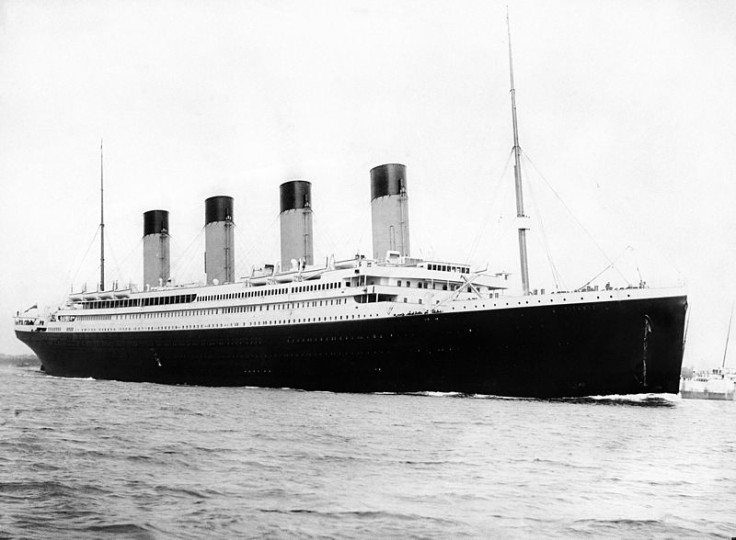
On April 15, 1912, just after 2:20 a.m. local time, the Royal Mail Ship "Titanic" sank below the still waters of the Atlantic Ocean, just over 700 miles east of Nova Scotia. Though there is no official word on whether "Take Her To Sea, Mr. Murdoch", was the phrase said by Captain Edward "E.J." Smith that sent "Titanic" on her way from Southampton, UK, the festiveness of the occasion did indeed change to heartache.
After calling in Cherbourg, France and finally Cobh, Ireland, Titanic was five days into a trans-Atlantic sail when she encountered an iceberg late on the evening of April 14, 1912 in the North Atlantic.
Around 11:40 p.m. on April 14, Frederick Fleet and Reginald Lee are peering westward from the crow's nest, keeping watch for icebergs. Suddenly, Fleet is heard yelling, "Iceberg, dead ahead!" As those in the wheelhouse attempt in vain to avoid the sudden sight, First Mate William Murdoch reportedly ordered the ship be thrown in reverse and steered "Hard to Starboard". But it was of course too late as the massive iceberg grazed the starboard bow of the "Titanic", filling too many watertight hull compartments to keep the ship permanently afloat.
She sank, along with more than 1,500 people, into the cold Atlantic waters, estimated to be 28 degrees Fahrenheit, never to be seen again. That is, until 1985 when scientist Robert Ballard found "Titanic"'s remains.
Reports and rumors from the early morning catastrophe made their way into James Cameron's 1997 motion picture "Titanic". Margaret Brown indeed traveled first-class, heading home to Denver. The "Unsinkable" Molly Brown, already known for her blunt style, is remembered best for ordering that "Titanic"'s quartermaster, Robert Hitchens, who was helming her lifeboat, return for the many passengers freezing to death in the icy water. Kathy Bates gave a memorable performance as Brown in the film.
J. Bruce Ismay, owner of the White Star Line, which commissioned "Titanic" indeed lived to see New York City a few days after the sinking. He and his fellow survivors were picked up by the "Carpathia" and brought the rest of the way to New York. Ismay was seen as a coward after the incident as he was one of the only major crew and management to survive the ship.
In the film, as his lifeboat is lowered from the deck, Jonathan Hyde's character of Ismay already looks embarrassed as he frowns and attempts to somewhat obscure his face from passers-by, as if he knew what was to come for his reputation. Ismay was additionally shunned because he allegedly violated the White Star Line's "women & children first" policy.
Captain E.J. Smith went down with the ship, as is somewhat custom for those helming doomed liners. First Mate Henry Wilde, Mr. Murdoch, and junior officer James Moody all perish with the "Titanic", as did Thomas Andrews, the designer of "Titanic", who in the film was last seen adjusting the clock in the First Class Dining Room.
Reports of the "Titanic" sinking denote that though the "Carpathia" was first on the scene in the early morning hours of April 15, that Captain Stanley Lord and the "S.S. Californian" were allegedly so close to the "Titanic" during the night that they could see the lights from the cabins of the doomed ship. However, Lord allegedly mistook the "Titanic"'s emergency flares as identification signals and no Californian crewmen woke the wireless operator to inquire as to the unknown ship's signals.
Many of the world's richest people, eager to be the first to sail on the much-publicized maiden voyage of "Titanic", unfortunately perished with the ship, including John Jacob Astor IV, the world's richest man at the time. Millionaire Benjamin Guggenheim, as well as Macy's Department Store owner Isidor Straus died aboard "Titanic".
There were also a number of survivors that survived because they either missed or decided not to sail on "Titanic": Milton Hershey of Hershey's Chocolates, "Titanic"'s financier, J.P. Morgan, and a number of others decided against sailing at the last minute, a decision that likely saved their lives.
In 2013, events worldwide are marking a historic, yet sad day in maritime history. In Belfast, Northern Ireland, where the "Titanic" was built, citizens placed flowers at a memorial outside the city hall. 28 people from the city died on "Titanic".
In the wake of the "Titanic"'s sinking, the United States Coast Guard founded the International Ice Patrol, which combs the colder parts of the Atlantic, keeping tabs on the dangerous floating blocks. Satellites and aircraft can sense the existence of icebergs in all weather conditions.
If an Australian billionaire has his way, however, "Titanic" may sail once again. Clive Palmer is reportedly in the process of designing a modern-day "Titanic" replica, which will sail in kind from Britain to America, but will have modern-day technology underneath the "cosmetic" attributes of smokestacks and wood veneer, which is more fireproof than the original's wall paneling.
Unfortunately for Palmer, in one of the aspects many "Titanic" survivors remember about the ordeal, Wallace Hartley and his string septet will not be able to join him if his plans go through, as they too sadly went down with "Titanic", to a very solemn rendition of Sarah Flower Adams' hymn "Nearer My God To Thee".
© 2025 Latin Times. All rights reserved. Do not reproduce without permission.




